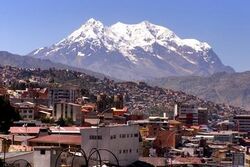Mount Lacara

|
This article or section is a work in progress. The information below may be incomplete, outdated, or subject to change. |

Mount Lacara, located in the Wechua Nation, is the largest and highest mountain in the country, and the 2nd-highest mountain in Keltia after Mount Guardian. With an elevation of 6,768 meters (22,205 feet) above sea level, Mount Lacara is one of the highest peaks in Micras. It is a dormant stratovolcano that last erupted over 10,000 AN years ago. Mount Lacara lies about 40 miles south-west of the capital city of the Wechua Nation, Parap, and can be seen from there on a clear day. The mountain is a famous sight in the Wechua Nation and holds immense cultural, spiritual, and ecological significance.
Mount Lacara is the crowning peak of the Lacaran Highlands, a vast mountain range that stretches across central and northern Wechua Nation. The Lacaran Highlands are characterized by their rugged terrain, deep valleys, and diverse ecosystems that range from tropical forests at lower elevations to permanent snowfields and glaciers at higher altitudes. The Lacaran Highlands are bisected by the mighty Rodinia River, creating two distinct sections, the Northern Lacaran Highlands (known for its more extreme elevations and harsher climate) and the Southern Lacaran Highlands (Home to Mount Lacara but generally more accessible terrain and is home to many Wechua communities).
History
Bear G. Rill's Expedition (1723)
In 1723 AN, Mount Lacara was the site of a controversial expedition led by Bear G. Rill, a climber from Vegno. Despite reaching the second-highest point of the mountain, the expedition faced significant criticism for alleged environmental violations and cultural insensitivity. The incident highlighted the delicate balance between exploration and respecting the mountain's status as a holy site for the Wechua people and followers of the Faith of Inti. The controversy led to diplomatic involvement, with the Vegnese government officially apologizing and offering to cover restoration costs. It also sparked broader discussions about responsible mountaineering practices in culturally significant areas. The incident underscored Mount Lacara's importance not only as a natural wonder but as a site of profound cultural and spiritual significance.
Geology
Mount Lacara is a stratovolcano composed primarily of andesite and dacite. Its last eruption, over 10,000 AN years ago, significantly impacted the surrounding landscape and Wechua oral traditions. The mountain's volcanic nature contributes to the fertility of the surrounding soil, supporting rich biodiversity and agricultural productivity in the region.
Cultural Significance
Faith of Inti
Mount Lacara holds profound spiritual significance in the Faith of Inti, the predominant religion of the Wechua people. The mountain is considered the earthly dwelling place of Inti, the sun god and supreme deity in the Wechua pantheon. Mount Lacara is a major pilgrimage site for followers of the Faith of Inti. Each year, thousands of pilgrims attempt to reach various sacred sites on the mountain's slopes. The most important ritual, the Festival of the Sun, takes place during the summer solstice, where elaborate ceremonies are performed to honor Inti and ensure his continued benevolence. Due to its ecological importance and cultural significance, Mount Lacara and its surrounding areas are protected as a national park. The Wechua government, in collaboration with international organizations, has implemented strict conservation measures to preserve the mountain's unique ecosystems and manage the impact of tourism and pilgrimage activities.